While you’d think that hurricanes and floods wreak the most havoc, there has been nothing more destructive to properties in the Somerset Hills than fires. The Mr. Local History Project is gathering information regarding large fires in the Somerset Hills area of northern Somerset County, New Jersey. Looking back at history, we’ve started digging to let the public understand how severe fires have devastated our community.
Bernards Township Fires
Bernardston Charter Destroyed in 1850 Fire
Basking Ridge – All township records before 1850 were destroyed in a fire. “Unfortunately, these charters were kept with so little care and were thus allowed to be destroyed.” The charter was the official township formation recognized by the King of England.
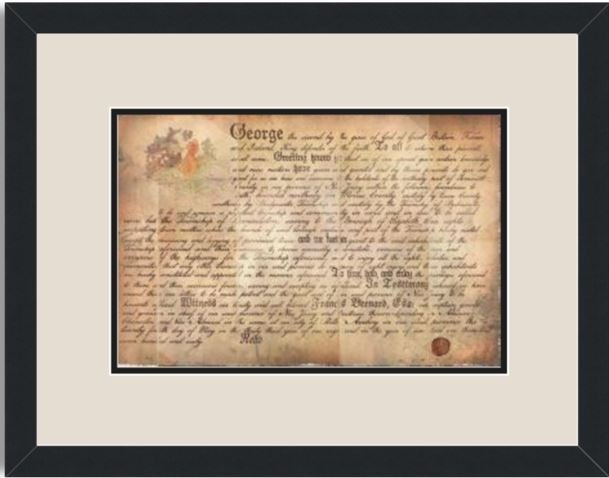
According to various written statements, the Bernards Charter was destroyed when the Bernards Township Municipal Office (or the Town Clerk’s home) burned during a fire in 1850. The Township keeps meeting minutes going back only to 1851 (at Town Hall)—the location of Bernards Township. The Town Clerk is still under investigation, but it isn’t easy to research since the Bernardsville News only goes back to 1897. But it is noted that back in that time, it was customary for Town Clerks to keep township records at home. The earliest recorded municipal meeting minutes in Bernards Township were signed by William R. Wilson, Clerk, in 1851.
Basking Ridge – The Great Fire of 1880
Numerous publications have hinted that massive fires have continually reshaped the landscape in downtown Basking Ridge. The Journeyman and the True Democratic Banner reported on the Great Fire of 1880 on April 14, 1880, in Basking Ridge.
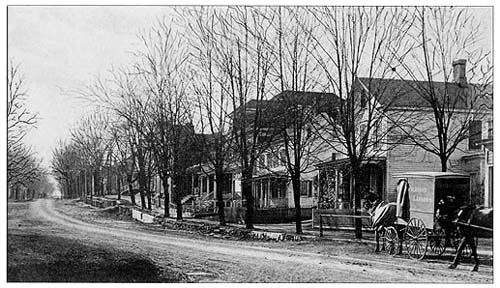

“About 4:40pm on Wednesday, April 14, 1880 the bakery of Mr. Balding (Belden) at Basking Ridge was discovered to be on fire, having caught from a bonfire burning next door. Mr. Balding (Belden) discovered the fire, which had burnt a hole about two feet square in the floor of his bakery, and as soon as possible a dispatch was sent to Morristown for help. An Independent Hose, Washington Steamer and the truck were ordered to proceed further. For a while it seemed as if nothing could prevent the larger part of the village from being destroyed, and a second dispatch was sent for the firemen to hurry.
The Hose Carriage with a horse attached started followed by a number of the members in Haddin’s carryall. The truck with four horses attached were ready to start, when a third telegram was received, stating that help was not needed. It was too late.
At this time the wind had changed to a more favorable direction, and with the aid of the “Bucket Brigade” formed by the young ladies of the place, the fire was confined to the bakery and dwelling of Mr. Belding (Belden) and the house of the Misses Oliver, occupied by Dr. Jones, which were entirely destroyed.
The sparks from the burning building were carried by the wind, the the Presbyterian Church, which was set on fire several times, but was quickly extinguished. Several other houses having shingle roofs were also set on fire. Ready hands soon carried out all that was possible to save, but most of the silverware, both of Mr. Balding (Belden) and Dr. Jones was lost. Mr. Balding’s (Belden) loss will amount to $7,000 and insured for $2,000. The Miss Oliver loss was $3,000, insured for $1,200. Most of the furniture was saved from the houses. Mrs. Jones was quite sick, and was carried from the house to a place of safety.
The Jerseyman – Morristown, New Jersey April 16, 1880 – the article misstated Mr Belden’s name as Balding.
The last fire at the Ridge occurred about thirty years ago (1850) at which time a considerable part of the business portion of the town was burned. The Hose Company had proceeded 2 1/2 miles when they were overtaken by the Chief and ordered back home. A few of the members, however, who were ahead of the carriage, went on to render what assistance they could, and were well entertained by the people of the village. A great deal of credit is due the young ladies who passed water from the wells during the entire time the fire was burning. Mr. Balding (Belden) allowed a considerable portion of his insurance to expire a short time ago when he built his bakery, as the rates were at that time increased, and he preferred to take the risk.”
The Jerseyman – Morristown, New Jersey April 16, 1880 – the article misstated Mr Belden’s name as Balding.
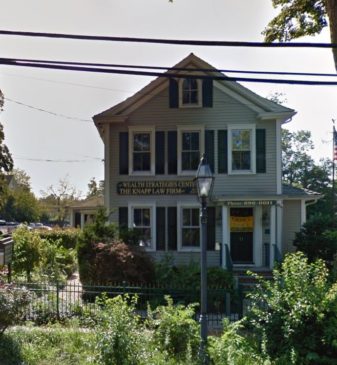
Image: Once Front Street, this building on 11 South Finley has long been in Basking Ridge. In 1853, the building was purchased by Bishop Edmund Storer Janes, who used the building as the meeting house for the Methodists. On June 2, 1853, at 8:00 pm, the Methodist Episcopal Church of Basking Ridge was formed in this house. Later, the house became the Basking Ridge Post Office and was owned by Postmaster William Scheuerman. The house burned completely in 1880 and, at the time, was owned by Miss Oliver (1873-1882). The complete loss was estimated at $8,000. Today, the building is the home of IDS Financial Services.
Source: Google Earth
The present building at 11 South Finley Avenue, dating from 1882, was once the lifetime residence of Postmaster William Scheuerman and served as the town’s post office from 1919 to 1952. It replaced an earlier one, the Basking Ridge Methodist Episcopal Church’s first home, which was also destroyed by the fire.
Thought now to be the oldest building on the block, the building at 21 South Finley Avenue was constructed as early as 1830. It was saved from the Great Fires by being covered with wet carpets and blankets. In the late 1880s, Robert Bishop had his home and harness shop here. Later, Dr. Frederick C. Jones, a prominent physician in the community for nearly 30 years, made it his residence and medical office.
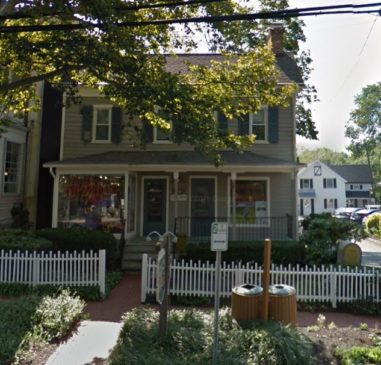
It was originally Robert Bishop’s harness shop, which was established in 1880. The house later served Dr. Frederick Jones for over 30 years. Gerald York Optometrists is one of the longest-standing buildings in the Basking Ridge Village. Source: Google Earth
Chief Engineer Halstead yesterday received two or three telegrams from Basking Ridge stating that a fire raged there threatening the entire place and asking the assistance of the Morristown Fire Department. He detailed Washington Steamer, Resolute Truck and Independent Hose to go to the aid of our distressed neighbors, and the fire alarm was sounded to secure a working corps of the companies. Independent Hose Company arrived, this time from Mr. D. D. Craig, stating that the fire was under control and the apparatus was not needed. Taking a buggy the Chief started after the Hose carriage and overhauling it near Mr. Bailey Breezes’ it was ordered back. The truck was in good shape, with four horses, for a speedy, trip, while the steamer was also well prepared.
The fire had originated in Mr. P.O. Balding’s (Belden) store building, on the South West Corner of the business part of Basking Ridge (corner of W. Oak and S. Finley today), and extended to his dwelling adjoining and also to a dwelling belonging to Miss Oliver of this place, burning all of these clean. Miss Oliver’s dwelling had just been occupied by Dr. Fred Jones, who’s sick wife was carried out in great haste by her friends. Belding’s store building was 1 1/2 stories high and filled with a stock of groceries etc. His dwelling was 2 1/2 stories. His loss was eight or nine thousand dollars, insured for $2,000.
Miss Oliver’s dwelling was two stories high, loss about $1,500, insured for $1,200. The dwelling adjoining Miss Oliver’s was saved by throwing we carpet etc. over it. (It is now known as 19-21 South Finley Avenue, Basking Ridge). There was a very high wind blowing directly from the burning building toward the Presbyterian Church and the greatest fears were entertained for its safety, but it is roofed with slate, and watchful care prevented it from being ignited by the leaves in the church yard, which were fired and in turn set fire to the fence.
During the fire an explosion occurred in the Balding (Belden) building that was heard a quarter of a mile away. It is supposed to have been a barrel of kerosene. The fire started from a bonfire of garden rubbish back of the store, a spark igniting the roof. There was no insurance on Mr. Belding’s store stock, but a large quantity of it, together with some of his and of Mr. Jones furniture was saved. It was stored in the church. Mrs. Moore’s dwelling opposite Miss Oliver’s was ignited by flying sparks, but saved by the bucket brigade.
Mr Balding (Belden) had allowed his insurance to run out only a short time ago and had intended renewing it in a new company but delayed from time to time. The last fire on note occuring in Basking Ridge occured about 1850 and consumed a row on the same street, but little above the present locality.
While speaking to those who did good work in subduing as well as preventing the spread of flames, we must not forget the young ladies who most nobly and energetically aided the stronger sexin the work.
Source: True Democratic Banner – Morristown, NJ April 16, 1880 – the article misstated Mr Belden’s name as Balding.
1895 Fire Almost Takes Basking Ridge Village
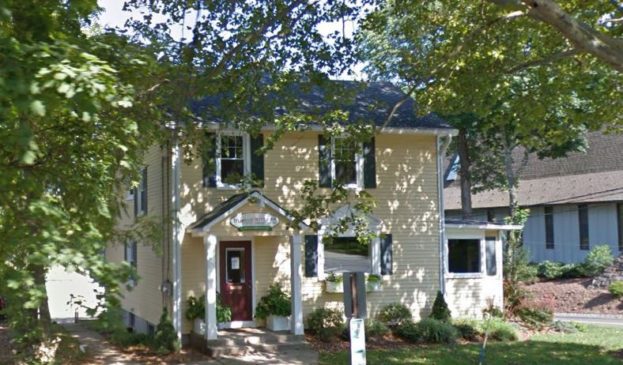
Fehn’s Bake Shop, the initial building on 134 South Finley, was owned by Hattie Whitnall. It was later named “ Bake Shop Hill” to Lewis Street. The bakery was destroyed by fire in 1895, and the present residence was built on the site. However, a fire in 1903 across Lewis Street became the impetus for forming the Basking Ridge Fire Company and St. Marks Church.
The Washington Hotel Fire of 1947
The famed Washington House was initially built in 1871. While there were a number of smaller fires at the establishment, the greatest fire destroyed the famed cupola. The fire started at 2:30 a.m. on December 2, 1947, and lasted until 2:30 a.m. Twenty-two sleepy guests were tossed out in the street as the fire raged after starting on the fourth floor and going down the staircase to the third floor.
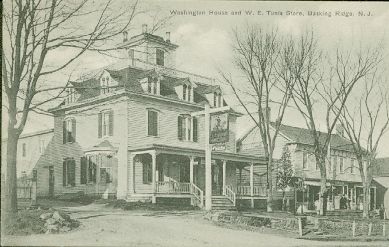
Raymond Harned, the owner then, estimated the cost to be over $25,000. The fire was guessed to have started from the chimney ashes in the attic. Mrs. Anne Scherzer, the owner of the Village Fountain next door, opened her store at 3 a.m. for the guests to come in out of the 18-degree cold.
Firebombings in Bernards Township – 1968
The most interesting thing we’ve learned about the Bernards Township Police Department’s history is that there were two firebombings at Stonehouse Station. Then, another firebombing occurred when the PD moved to the Astor Estate. All three incidents were never solved.
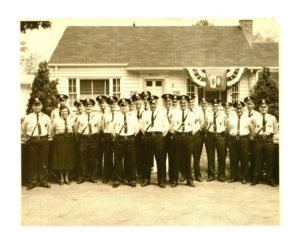
On April 16, 1968, a second firebomb was reported in the New York Times at the Stonehouse police station. Chief Harry M. Allen was in charge at the time. No one was in the building at the time. Two Molotov cocktails were thrown through a side window. A second bomb failed to go off. At least half of the building and the furnishings were destroyed. The chief stated that while he thought it was not racially motivated, it was most likely the work of someone holding a grudge against the police. The fire caused about $7,500 in damage. This was the second attempt in the last 10 days. The first bomb landed on the roof. The police later recognized that milkman Joseph Yuhas of Bernardsville was the hero, as he was the first to call in the alarm just past 4 am and rushed to put water on the fire with a hose.
A temporary headquarters was set up in a former Basking Ridge Presbyterian Church office space on 12 Allen Street, just north of the church. They stayed there until September 1969, when they moved to the Astor mansion on Collyer Lane.
Third Basking Ridge Firebombing – 1974
After the move to the new facility, after the township purchased the Astor Estate, the new police headquarters and the municipal courtroom at the front right of the estate were firebombed at 2 am on the morning of October 6, 1974. It was later reported that the crime was tied to a stolen patrolman’s motorcycle that was later recovered in a wooded area near the Cedar Hill School. A five-gallon “GI-style” gas can with combustible liquid was found on the courtroom floor. All three of the firebombings were never solved.
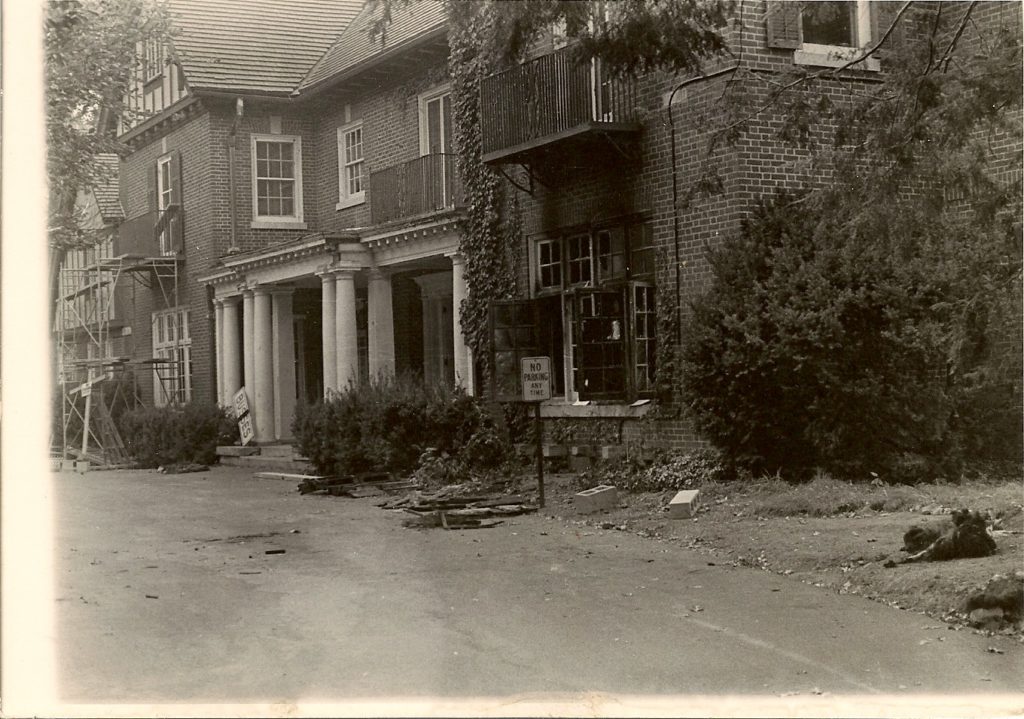
Bernardsville’s Most Historic Fire
The Somerset Inn Fire – May 6, 1908

It was reported that when the Somerset Inn opened for the 1903 Summer Season, guests arrived by train and carriage from Virginia, New York, Canada, Princeton, Newark, and Plainfield. During the season, a weekly article in the Bernardsville News reported various activities and new arrivals. In August of 1907, one particular item indicated that “Thomas Edison and the party came to the Somerset Inn on Sunday from East Orange.” Then, one of the greatest tragedies in Somerset Hill’s history happened in May 1908.
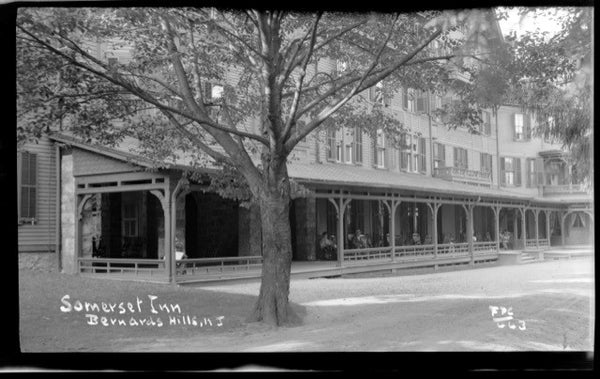
In the early morning of May 6, 1908, a fire struck the Bernardsville Mountain’s Somerset Inn. Just off what is now Mendham Road, the fire engulfed the entire 500-guest hotel and took the eight cottages on the property. You could see the light from the fire for miles down to the railroad tracks in the Bernardsville village. Chief Sanford W. Tunison, Bernardsville Fire Chief, arrived just about 1:30 am. The alarm was sounded at 1:40 am. Fire departments from Mendham and Peapack came to help save the structure, but to no avail. It is thought that the fire started in the kitchens and spread to the dining rooms.
The inn had a capacity of about 500 guests, and there were known to be 100 bathrooms attached to the suites in the facility. The fire destroyed the Somerset Inn just weeks before the June 1st season opening. Evander H, Schley was insured to about 80% of the cost, and the loss was estimated at $200,000. Sadly, it was never rebuilt. The fire left over 20 chimneys standing alone on the property.

Twenty years later, on Monday, February 13, 1928, the clubhouse that adjoined the golf course also burned to the ground. The only remaining thing from the Inn is two entrance pillars off Mendham Road.
Bakery Fire Almost Takes Entire Bernardsville Business District -1917
On the early morning of Sunday, January 11, on the Viedt Block on Main Street, a fire started in the basement of L. Mischiara’s bakery, causing over $1,000 in damages. Pasquale Grisselli’s shoe store next door also suffered substantial damage. Quick work by the local fire department prevented the spread of the fire, which most likely would have taken the entire block. Special thanks went out to Fire Chief Edmund Spinning for reacting quickly to the alarm.
Stonemere Estate Collapses – 1969
STONEMERE (formerly Order of the Eastern Star Home)
Washington Corner Road 1955 – 1973
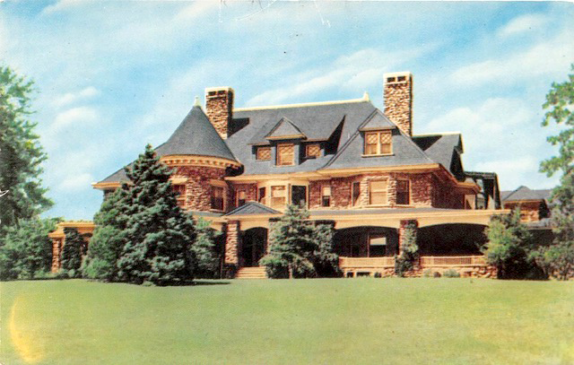
Stonemere opened as a nursing facility in September 1955 under the management of Mrs. F. Doherty, R.N. The Bernardsville News described it as the “Cadillac of Nursing Homes–Quality, luxury, and service at moderate rates.” A postcard promoting the home is above. Over the next 14 years, municipal boards denied many attempts to expand the facility.
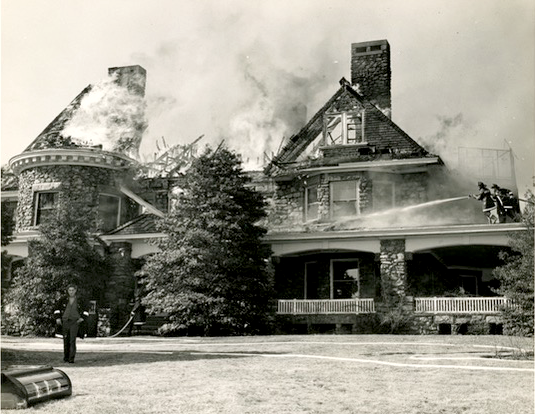
On April 3, 1969, a fire destroyed the building, and 29 elderly patients were moved by ambulance to Bernardsville Elementary School. Being two miles from the town center with no hydrants, water availability hampered the effort to save the residence. Mrs. Doherty’s request for permission to rebuild was denied in March 1970, and the property was sold for development. In 1973, five-acre lots were available on the new street, Carriage House Road.
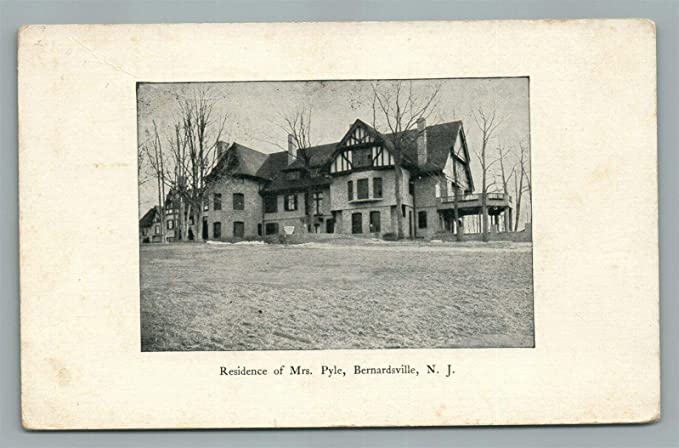
Oakdene Estate is at 475 Bernardsville Road in Mendham. The property was sold to William Scott Pyle in 1902, and his family lived there for 22 years. William Pyle died in 1906, and his wife, Mary Vanderhoef Pyle, kept the estate. The estate burned in about 1990.
Bernards Home Supply – Saturday, December 21, 1974
Seventy firemen responded to the alarm. Albert Alpaugh was the Bernardsville Fire Chief at the time. The glow in the sky could be seen for miles. Some say flames reached over 300 feet tall, reducing the lumber yard to rubble. No firewalls were separating the businesses, so Colonial Cleaners and the barber shop were heavily damaged.
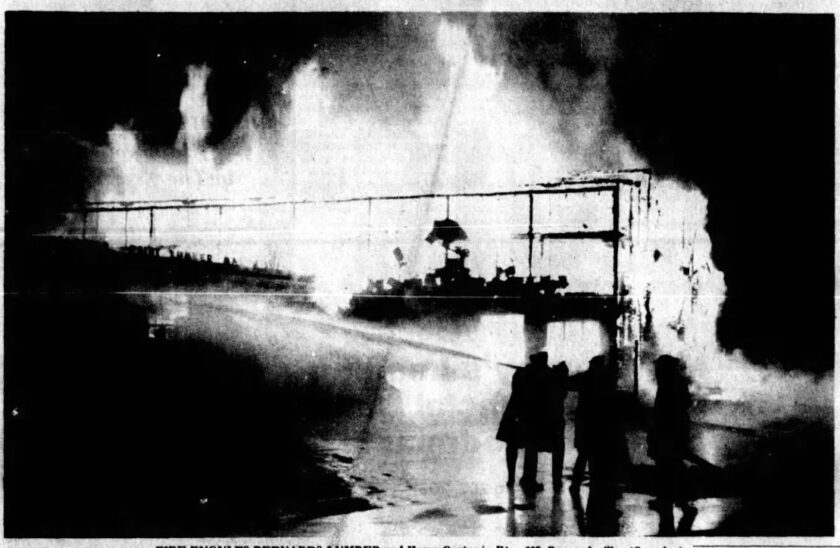
The lumber yard was built in 1925 and, at the time of the fire, was owned by the Griffith family before being purchased by Joseph Dobbs, a local real estate agency and developer. In 1925, Dobbs helped build the store that became Piper’s Restaurant. Then, in the 1950s, the A&P was built on the site. Over the years, the builder site has been named Bernards Builder Supply Company, Bernards House and Garden Supply Company, and Bernards Lumber and Home Center, Inc.
Bedminster Fires
Like Bernards Township, in 1845, it was reported that the Charter of Bedminster was burned at the home of Aaron Longstreet of Lamington, the Township Clerk at the time. Now known not to be true, the Bedminster Charter is in good hands, with the Bedminster Township government having recently been donated by the Forbes family.
Hamilton Farm Fires of 1923 & 1978
Wall Street financier and magnate James Cox Brady (not “Diamond” Jim Brady), who was close friends with Thomas Edison and also interested in gas and electric lighting, built Hamilton Farm and named it after his third wife’s family name. Quickly growing from 180 to 5,000 acres, the homestead included an extensive horse barn with a storage area for a large carriage collection.

Hamilton Farm started in 1911 when James Cox Brady decided to create an English-like country estate in the green fields and woodlands of the Somerset Hills in Bedminster. Cox gathered almost 5,000 acres, creating one of the largest farms ever. When the clapboard house was completed, on Monday, March 12, 1923, at 6 pm, it was reported to the Peapack Fire Department. The 75-room residence burned to the ground, with a loss of over $500,000.

Source: Bernardsville History Room
After rebuilding, the new estate stood unscathed for 55 years, and in 1978, a fire struck again on the Hamilton Farm estate. The Beneficial Corporation had just contracted to purchase the property from the Brady family. The closing was marred by a massive fire that destroyed the mansion down to the foundation. Without hesitation, Beneficial Corporation continued with the purchase and contracted with designer Percy Leach to restore the mansion to its grandeur. The fabulous estate is part of the Hamilton Farm Golf Club and is noted as being one of the best in the country.
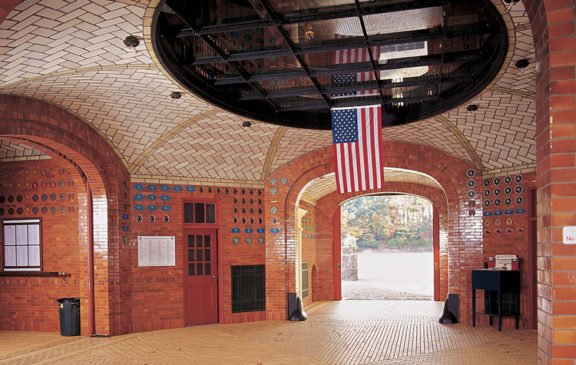
Not only did the main house suffer from fire, but Brady also had a significant fire that burned his carriage and stable facility to the ground. When this stable burned, Brady resolved to rebuild an even grander facility and included fire-proofing measures that were virtually unheard of at the time. The new barn featured a carriage storage area and a fifty-stall stable. The barn was also used as a hospital during WW2.
Peapack / Gladstone Fires
Blair’s White Cottage/ Keith (Manhattan Project) Windfall Burns in 2009
The 16-room mansion on Highland Avenue known as “Windfall” was unoccupied at the time of the fire around 9 p.m. Peapack-Gladstone Mayor William Horton, who lives next door, said he saw flames 50 feet in the air.
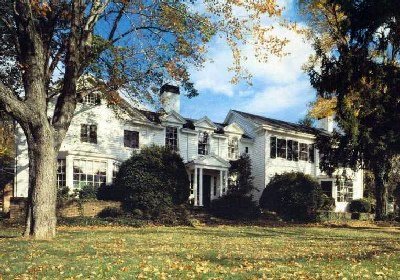
The Blair family dubbed the Melick farmhouse “White Cottage” and used it as their country home when Blairsden was being built. Located next to the famed Natirar estate — once owned by the King of Morocco and now being transformed into a luxury spa by Virgin mogul Richard Branson — the house dates back to the mid-18th century, when it was built as a stone farmhouse on the hilltop of a sprawling farm owned by the Melick family, according to “The Somerset Hills.”
“I know the house well,” Turpin said today. “When I heard this morning that it had burned, I was dismayed because it’s one of the landmarks around here.”
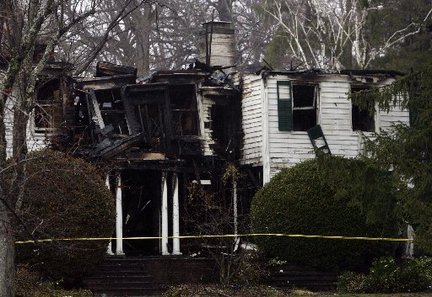
White Cottage was later separated from Blairsden when Percival Cleveland Keith, a chemical engineer famous for his work on the Manhattan Project, purchased the property in 1933.
Essex Fox Hounds Fire – 2016
Begun in Essex County in the late 19th Century, the Essex Fox Hounds moved west to Peapack-Gladstone around the turn of the 20th Century. The group continues to hold traditional fox hunts, and the Essex Fox Hounds, a breed of American hound, are a beloved part of local events like the Raritan Headwaters Association’s Old Fashioned Country Fair in Bedminster.
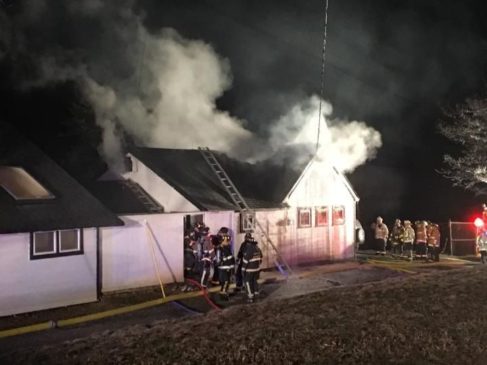
You’d have to go back over 100 years to November 1903, when there was a fire at Charles Pfizer’s Gladstone Kennel. Fire destroyed one of the stable buildings and a shed on the kennel farm. Thomas Maddan, the foreman at the site, was credited with creating a bucket brigade, which saved the day. No horses were harmed in the fire. The site was the second site for the Essex Fox Hounds that Pfizer bought and brought to Bernardsville, then moved to Gladstone.
Firehouses & Firefighters
It should be noted that all of the Somerset Hills firemen and firehouses have been volunteers since their inception. Each town formed its department, which was formed in the late 1800s through the early 1900s. Below are a few images of the properties.
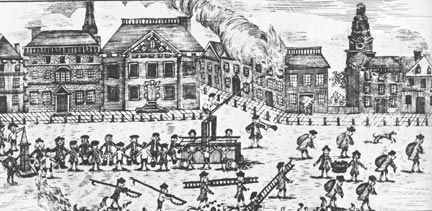
Basking Ridge Fire of 1903 and a New Fire Company
One of the major fires in Basking Ridge, which indicated the need for a fire company, occurred in the fall of 1903 when Charles Wickenhaver had the misfortune to have his large barn with contents and four horses burn. That winter, there was talk about organizing a fire company, and on May 30, 1904, names were secured of those willing to give their time and talents as members. Almost a month later, on June 24, 1904, a meeting was held with Fred C. Sutro presiding, when the Basking Ridge Fire Company was formally organized. Its officers were elected: Chief J. Walter Allen, Secretary, Raymond A. Henry, Treasurer, Charles M. Allen, and Wardens, Harry W. Bennett and Frank J. Happe.
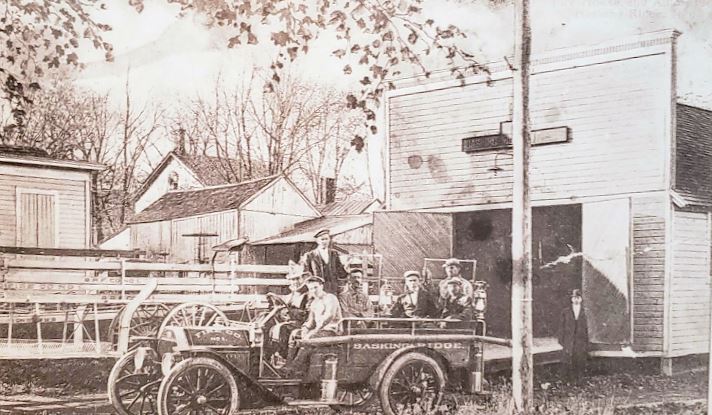
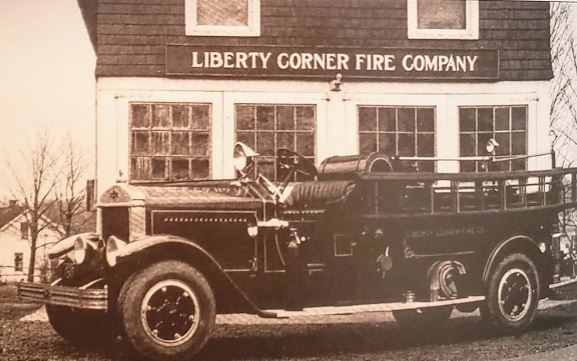
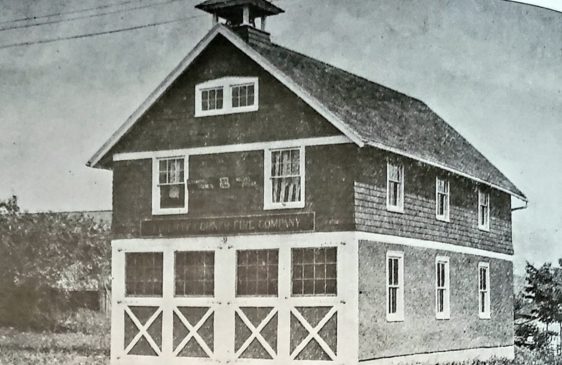
Founded in 1897, the Bernardsville Fire Company was the first fire department in the nation (paid or volunteer) to be fully radio-equipped!
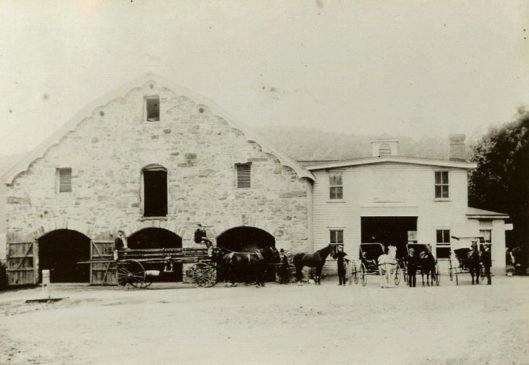
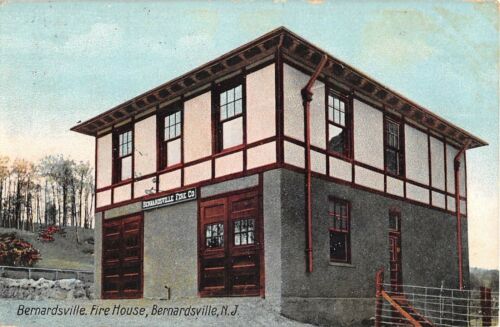
At the corner of Henry Street and South Maple Avenue is the earlier firehouse of Basking Ridge Fire Company Number 1, organized in 1904. The red brick building with a clay tile roof was constructed in 1915 for $10,000.
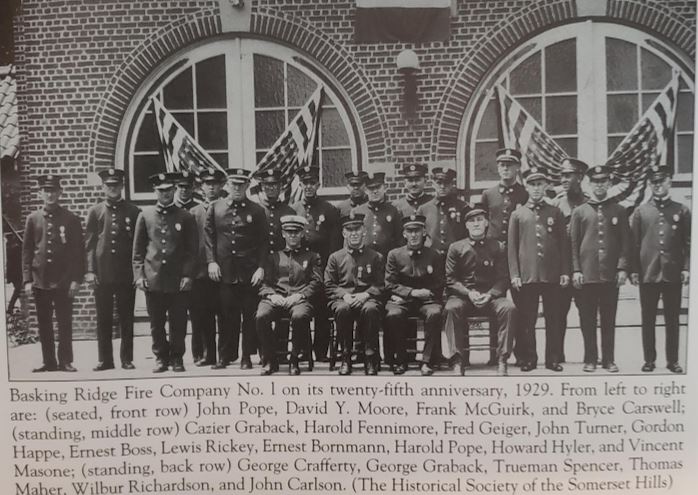
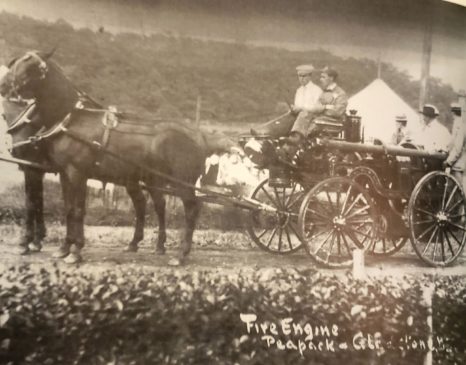
The Peapack & Gladstone Volunteer Fire Company has served the community since 1905.
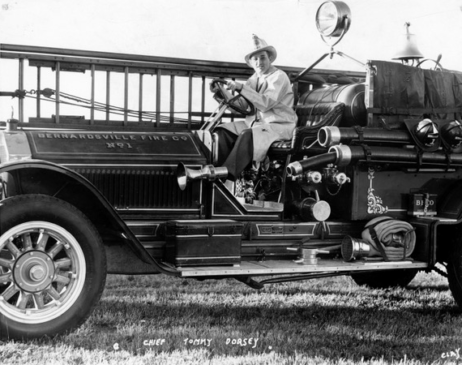
Other Unforgettable Fires in the Somerset Hills
- The 1760 charter of Bernardston is said to have been burned in a fire in 1850 at the home of the Township Clerk. Read the story.
- The history of fires in Basking Ridge (part of the 100th-anniversary celebration)
- Somerset Hills Quarterly -The Charter of Bernardston Burns
- Basking Ridge fire of 1843 (searching)
- Basking Ridge fire of 1850 (searching)
- Basking Ridge fire of 1881 (searching)
- Somerset Hills Quarterly Vol 5 (Somerset Hills Quarterly Vol 2 pg 103. – Charter burns Bernardsville News looks back at the Somerset Inn Fire of 1908
- The 1903 fire at Charles Wickenhaver’s farm was the barn fire that prompted the formation of the Basking Ridge Fire Company. The farm later became the grounds for the St. Marks Church!
- 1909 fire that destroyed the Dumont Lumber Yard in Far Hills
- 1915 Fire destroys Lawson house in Far Hills – 1915 Bernardsville News
- 1917 Stone Crusher Fire causes extensive damage – Bernardsville News
- 1927 – Three fires on Schley Estate caused $500,000 in damages – reported on August 18, 1927, being caused by cigarettes and thunderstorms.
- Bernardsville News 1947 – A look back at the greatest fire in Bernardsville History
- 1934 Fire destroys Brooder House in Dewey Meadow (Bernardsville News)
- John Copperthwaithe fire in Far Hills
- 1948 – Bernards Inn fire – March 1948
- 1975 – Joseph “Jumbo” Luccis dies in a fire at Mooreland Farm in Far Hills
- 1976 fire destroys Basking Ridge’s Pennbrook Golf Club – “The Club” and “Porch Lounge” were destroyed and owner promised to rebuild.
- The firebombings at two Bernards Township Police Departments go unsolved.
- Official Bernards Township Clerks (tied to the Great Fire of 1850)
- 1851 William R. Wilson
- 1852-1853 John S. Quimby
- 1854-1855 James W. Arrowsmith
- 1856-1857 Benjamin Smith
- 1858-1859 James W. Arrowsmith
- 1860 Ira B. Pruden
- 1861 John W.B. Lewis
Original Post: December 29, 2019
Updated: May 3, 2025

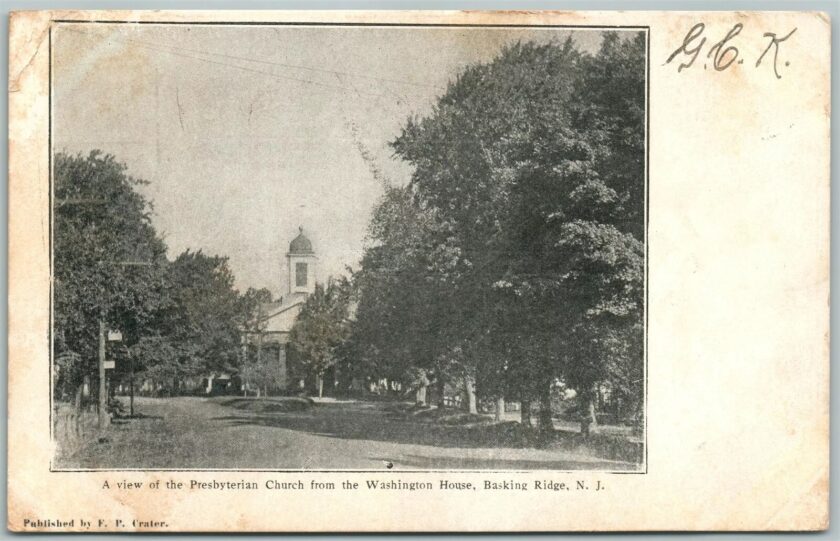
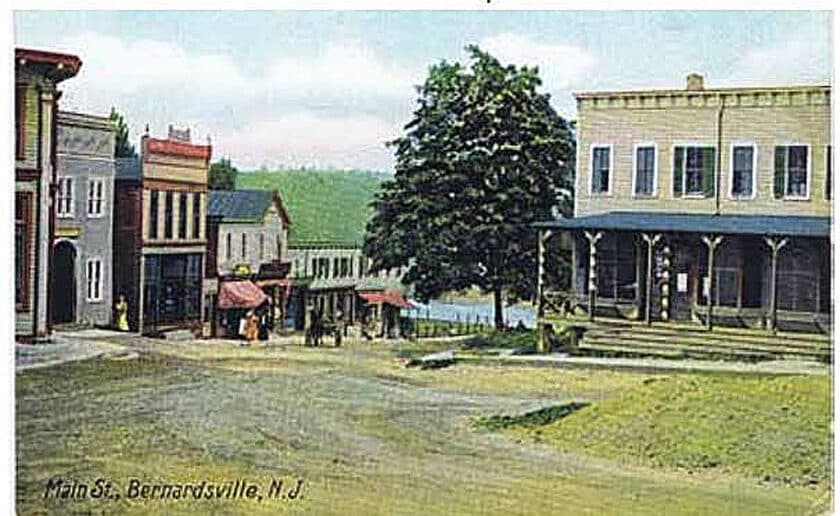
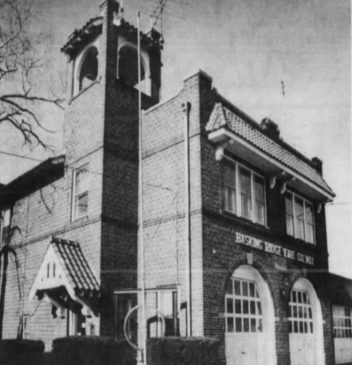
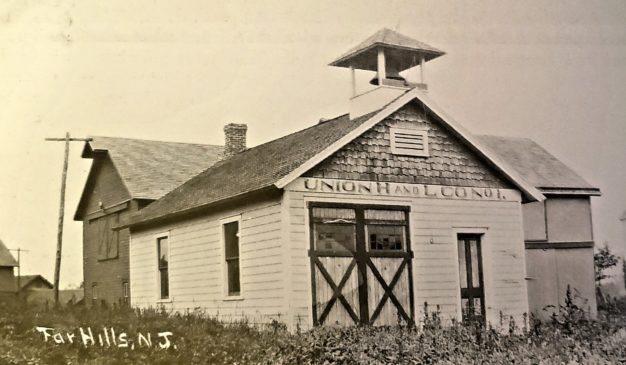
John M Babyak wrote – Week before the ‘78 Hamilton Farm fire, I was on security guard duty at Hamilton Farm, specifically watching the US Equestrian Team HQ. Falls City Security was my employer. The night of the fire, I was inexplicably reassigned to another job site. Had I been there, I would have seen the fire start no doubt and could have called in help. I’m still suspicious of the circumstances. A classmate of mine from UVM perished in the fire.
James Alexander posted on FB ” working that night when the P.D. at astor estate fire bombed we caught that guy”
Martha Brown Heiner posted on FB – How about the fire in the barn of the Charles Wickenhaver property in 1903 which prompted the organization of Basking Ridge Fire Co. in 1904? Wickenhaver sold the property to St. Mark’s Church in 1909.
Martha Brown Heiner wrote on FB – Mr.Localhistory I actually have a B’ville news article. Check around July 2004 there was an article by Jake on the Celebration of the 100th anniversary of the fire department. If you can’t find it , I can supply a copy. Good discussion of other historical fires too. Also, there is a book on history of St. Mark’s (The Lion’s Tale) which discusses this event too, and has a picture of Charles Wickenhaver and family standing outside his home (the current church rectory).
James Alexander wrote on FB – Steve Gilley’s motorcycle was pushed down to Cedar Hill school and was found there I’m pretty sure the subject who did it was charged. Steve Gilley was working the desk when he smelled the smoke. Dennis Couldron and I were working the road when a 5 gallon gas can was thrown into the front courtroom window. It was a mixture of two types of paint. The gas can was found in the subjects garage.
My dad, Thomas Maher, is in the 1929 picture of the Basking Ridge Fire Department. He was 18 years old.
No mention of the July 1961 fire that destroyed “Dunliegh” at the top of Mine Mount road in Bernardsville. Burned for 3 days, and my grandmother perished in it.
Hello,
I am a descendant of the Allen family in Liberty Corner, New Jersey (Basking Ridge, Bernards Township, etc.).
I’ve been studying my ancestry and would like to learn more about the Allen family.
Are you able to help? Please let me know. I’d be happy to speak over the phone if that is easier. Email is fine too.
Ancestry.com would be your best start. Once you’ve identified your thread of decendents, then we could possibly connect and compare. One of our trustees live just behind the Will Allen (local police line) and Michelle Allen (my strong NY Rangers fan) but not the Allen Road line, which might be your line.
Thank you
August 1968 Somerset Grain and Feed fire.